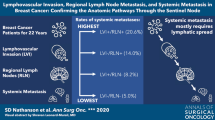Abstract
Background
There are many cases of breast cancer with axillary lymph node metastases without lymphatic invasion. We hypothesized that in these cases cancer cells may pass through the retro-mammary space (RS) into lymph nodes and that axillary lymph node metastases may correlate with the tumor invasion of the RS.
Methods
A total of 127 patients who had undergone radical operation between April 1997 and April 2001 were studied. Whether or not the tumor had invaded the RS was histologically examined with hematoxylin and eosin staining of sections made at the point where the distance between the tumor and the fascia of the major pectoral muscle was the shortest.
Results
Eighty-five cases did not have lymphatic invasion. Twenty-nine of these 85 cases had RS invasion and 56 cases did not. Among the 29 cases with RS invasion, 14 cases had lymph node metastases. In contrast, of 56 cases without RS invasion only 3 cases had lymph node involvement. Of the 85 cases without lymphatic invasion, the relationship between RS invasion and lymph node invasion was statistically significant (RS(+) vs. RS(-),p < 0.0001,X 2 test). For all 127 cases, if cases showing either lymphatic invasion or RS invasion were diagnosed with lymph node involvement, the sensitivity, specificity, accuracy, and negative predictive value were 93.5%, 65.4%, 75.6% and 94.6%, respectively.
Conclusion
These data suggest that lymph node metastases may occur via the tumor cell migration through lymphatic vessels and the RS.
Similar content being viewed by others
Abbreviations
- RS:
-
Retro-mammary space
- SLNB:
-
Sentinel lymph node biopsy
- ly:
-
lymphatic invasion
References
Hayward J: The surgeon’s role in primary breast cancer.Breast Cancer Res Treat 1: 27–32, 1981.
Cabanes PA, Salmon RJ, Vilcoq JR,et al: Value of axillary dissection in addition to lumpectomy and radiotherapy in early breast cancer for the Breast Carcinoma Collaborative Group of the Institute Curie.Lancet 339: 1245–1248, 1992.
Petrek JA, Blackwood MM: Axillary dissection; Current practice and technique.Curr Probl Surg 32: 259–323, 1995.
White RE, Vezeridis MP, Konstadoulakis M,et al: Therapeutic options and results for the management of minimally invasive carcinoma of the breast; Influence of axillary dissection for treatment of Tla and Tlb lesions.J Am Coll Surg 183: 575–582, 1996.
Hladiuk M, Huchcroft S, Temple W,et al: Arm function after axillary dissection for breast cancer: A pilot study to provide parameter estimates.J Surg Oncol 50: 47–52, 1992.
Maunsell E, Brisson J, Deschenes L: Arm problems and psychological distress after surgery for breast cancer.Can J Surg 36: 315–320, 1993.
Leong SPL, Morita ET, Treseler PA,et al: Multidisciplinary approach to selective sentinel lymph node mapping in breast cancer.Breast Cancer 7: 105–113, 2000.
Turner RR, Ollila DW, Krasne DL,et al: Histopathologic validation of the sentinel lymph node hypothesis for breast carcinoma.Ann Surg 226: 271–278, 1997.
Schreiber RH, Pendas S, Ku NN,et al: Microstaging of breast cancer patients using cytokeratin staining of the sentinel lymph node.Ann Surg Oncol 6: 95–101, 1999.
Czerniecki BJ, Scheff AM, Callans LS,et al: Immunohistochemistry with pancytokeratins improves the sensitivity of sentinel lymph node biopsy in patients with breast carcinoma.Cancer 85: 1098–1103, 1999.
Turner RR, Ollila DW, Stern S,et al: Optimal histopathological examination of the sentinel lymph node for breast carcinoma staging.Ant J Surg Pathol 23: 263–267, 1999.
Chadha M, Chabon AB, Friedman P,et al: Predictors of axillary lymph node metastases in patients with T1 breast cancer: A multivariate analysis.Cancer 73: 350–353, 1994.
De Laurentiis M, Gallo C, De Placido S,et al: A predictive index of axillary nodal involvement in operable breast cancer.Br J Cancer 73: 1241–1247, 1996.
Choong PL, De Silva CJS, Dawkins HJS,et al: Predicting axillary lymph node metastases in breast carcinoma patients.Breast Cancer Res Treat 37: 135–149, 1997.
Olivotto IA, Jackson JSH, Mates D,et al: Prediction of axillary lymph node involvement of women with invasive breast carcinoma: a multivariate analysis.Cancer 83: 948–955, 1998.
Author information
Authors and Affiliations
Additional information
Reprint requests to Yoshiaki Nakano, Department of Surgery, NTT West Osaka Hospital, 2-6-40, Karasugatsuji, Tennoji-ku, Osaka 543-8922, Japan.
About this article
Cite this article
Nakano, Y., Monden, T., Tamaki, Y. et al. Importance of the retro-mammary space as a route of breast cancer metastasis. Breast Cancer 9, 203–207 (2002). https://doi.org/10.1007/BF02967590
Received:
Accepted:
Issue Date:
DOI: https://doi.org/10.1007/BF02967590




